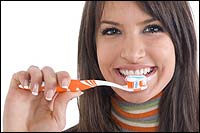Proper Brushing Technique
| |
 |
"Brush your teeth... round and round" we all remember the song. It's amazing, though, how many people still use improper brushing techniques. Brushing your teeth properly with a good tooth brush is your best line of defense against cavity-causing plaque between dental visits.
Improper brushing can be just as, if not more, harmful than plaque itself. Brushing too hard or using an improper tooth brush can erode enamel on the sides and tops of your teeth as well as damage your gums. Don't be discouraged though, proper brushing technique is easy and rewarding.
It is recommended that you brush your teeth after every meal, and especially before your go to sleep, as bacteria will remain unchallenged for an extended period while you sleep.
Techniques
How long you spend brushing your teeth is as important an aspect as how often you brush your teeth. Often people "rush the brush", spending under 30 seconds brushing, followed up by a quick mouthwash rinse. Brushing your teeth should be a part of your morning ritual and your bedtime wind-down. Brushing should take no less that two minutes if done properly, followed by a flossing regimen, then at least one minute with a mouthwash if you choose to use one. These five minutes can be very relaxing and will leave your gums and mouth feeling invigorated and clean.
Brushing your teeth is not like sanding wood, you need to be gentle. Using a soft bristled brush, in a small circular motion, ensure you clean all surfaces of your teeth including behind the hard to reach back molars. Don't forget to gently brush your gums in the direction of your tooth (upwards for lower teeth, downwards for upper teeth).
Your tongue and roof of your mouth need to be brushed gently. Some tooth brushes come with a tongue scrubbing surface: as long as you're gentle, your brush should do the trick. This will help control the majority of the bacteria that cause bad breath.
Your toothbrush
Your toothbrush is your toothbrush - don't share it. If you use an electric toothbrush get separate brushing heads for each user.
Unless your dentist suggests otherwise, choose a brush with soft bristles. There are many shaped toothbrush heads and bodies: select one that fits your mouth and is easy to handle, ensuring you can reach behind your back molars.
A toothbrush should be changed about every three months, and whenever you see that the bristles are starting to fray and bend. We also recommend replacing your toothbrush after you have a cold or other virus.
Taking the time to care for your teeth and mouth will benefit your overall health and be well worth the effort. If you would like a demonstration of proper brushing techniques, please ask us during your next visit.
|
|



